Uncut fan print (uchiwa-e), 295 x 230 mm, depicting kabuki actor Bandō Shūka I as Shirai Gonpachi (白井権八) reading a scroll by the light of a lantern. From the series A Parody of the Five Chivalrous Commoners; a Cup of Sake From Their Fans (Mitate gonin otoko, go-hiiki no omoizashi). According to Paul Griffith, the term omoizashi refers to the act of pouring a cup of sake for one's chosen partner, here giving an impression of intimacy and affection between famous actors and their patrons.
Actor: Bandō Shūka I [初代坂東しうか] (Japanese, 1813-1855); other names: Bandō Tamasaburō I, Bandō Mitsugorō V (posthumously). The print was probably published by some unknown Yama-Ta (Marks U421b). Double nanushi censor seals and date seal: Muramatsu and Fuku, Kaei 5, 2nd month (2/1852). As Kabuki Encyclopedia put it: "Gonpachi. A parasite. From the character named Shirai Gonpachi who lives at the home of Banzui Chōbei and sponges off him" (An English-Langauge Adaptation of Kabuki Jiten. Samuel L. Leiter. Greenwood Press, 1979, pp. 26, 98-9). There were many kabuki plays based on the story of the lovers Miura-ya Komurasaki and Shirai Gonpachi. (See: [LIB-2226.2019] Algernon Bertram Freeman-Mitford. Tales of Old Japan. — London: Macmillan and Co., 1883). Ref.: Art shop Ezoshi Ukiyoe new collection news, vol. 66, 2023.1 (Jan) # 31, p.8.-
 Utagawa Kunisada [歌川 国貞] a.k.a. Utagawa Toyokuni III [三代歌川豊国] (Japanese, 1786 – 1865).
Utagawa Kunisada [歌川 国貞] a.k.a. Utagawa Toyokuni III [三代歌川豊国] (Japanese, 1786 – 1865). -
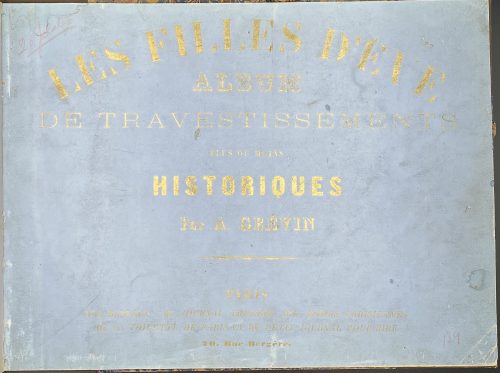 Pictorial album of 20 hand-coloured wood engravings by Firmin Gillot after Alfred Grévin; numbered 1 to 20, bound with tissue guards in half-brown cloth over marbled boards, publisher's gilt-lettered blue wrappers preserved, purple-blueish endpapers. Front wrapper (gilt on blue): LES FILLES D'EVE | ALBUM | DE TRAVESTISSEMENTS | PLUS OU MOINS | HISTORIQUES | Par A. GRÉVIN | — | PARIS | AUX BUREAUX : DU JOURNAL AMUSANT, DES MODES PARISIENNES | DE LA TOILETTE DE PARIS ET DU PETIT JOURNAL POUR RIRE | 20. Rue Bergère. || ; Henri Plon's imprint to back wrapper. Contributors: Grevin, Alfred (French, 1827 – 1892) Gillot, Firmin (French, 1820 – 1872) Plon, Henri (French, 1806 – 1872) Ref.: Metropoliten Museum.
Pictorial album of 20 hand-coloured wood engravings by Firmin Gillot after Alfred Grévin; numbered 1 to 20, bound with tissue guards in half-brown cloth over marbled boards, publisher's gilt-lettered blue wrappers preserved, purple-blueish endpapers. Front wrapper (gilt on blue): LES FILLES D'EVE | ALBUM | DE TRAVESTISSEMENTS | PLUS OU MOINS | HISTORIQUES | Par A. GRÉVIN | — | PARIS | AUX BUREAUX : DU JOURNAL AMUSANT, DES MODES PARISIENNES | DE LA TOILETTE DE PARIS ET DU PETIT JOURNAL POUR RIRE | 20. Rue Bergère. || ; Henri Plon's imprint to back wrapper. Contributors: Grevin, Alfred (French, 1827 – 1892) Gillot, Firmin (French, 1820 – 1872) Plon, Henri (French, 1806 – 1872) Ref.: Metropoliten Museum. -
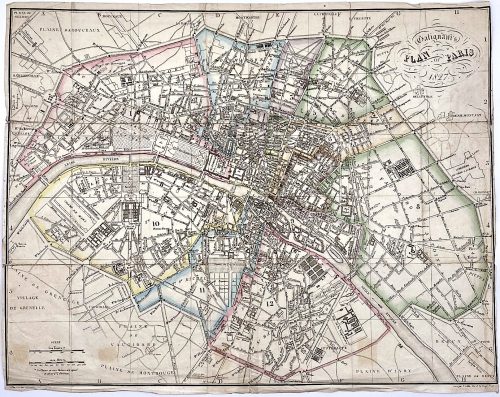 Upper right: Galignani's | PLAN OF PARIS | 1827 || in oval frame: Sauve sculpt. Bottom, under the frame: le Plan écrit par Lallemand. […] Gravé par E. Collin. Rue de la Harpe № 45. Dimensions: 36.5 x 46.5 cm. Armand Joseph Lallemand (French, c. 1810 - 1871) – cartographer. Charles-Étienne Collin (French, 1770 – 1840) – engraver. Étienne Collin II (French,1790 – 1852) – engraver. John Anthony Galignani (Italian, 1796 – 1873) – publisher. William Galignani (Italian, 1798 – 1882) – publisher.
Upper right: Galignani's | PLAN OF PARIS | 1827 || in oval frame: Sauve sculpt. Bottom, under the frame: le Plan écrit par Lallemand. […] Gravé par E. Collin. Rue de la Harpe № 45. Dimensions: 36.5 x 46.5 cm. Armand Joseph Lallemand (French, c. 1810 - 1871) – cartographer. Charles-Étienne Collin (French, 1770 – 1840) – engraver. Étienne Collin II (French,1790 – 1852) – engraver. John Anthony Galignani (Italian, 1796 – 1873) – publisher. William Galignani (Italian, 1798 – 1882) – publisher. -
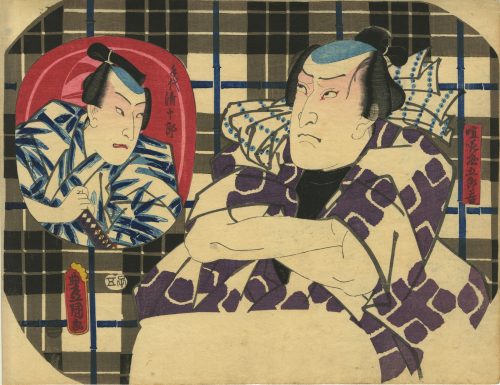 Artist: Utagawa Kunisada [歌川 国貞] a.k.a. Utagawa Toyokuni III [三代歌川豊国] (Japanese, 1786 – 1865). Publisher: Ibaya Senzaburō [伊場屋仙三郎] (Japanese, fl. C. 1845 – 1847). Date seal: [子五] Kaei 5, 5th month (5/1852). Signed: Toyokuni ga [豊国 画] in a red toshidama cartouche. Title: Actor Bandō Takesaburō I as clerk Seijūrō [手代清十郎] (left) and Actor Ichikawa Kodanji IV as Kenkaya Gorōkichi [喧嘩屋五郎吉] (right) in the play Musume ōgi tsui no tatehiki [娘扇一対侠贔屓 (むすめおうぎついのたてひき)] performed at the Nakamura theatre [中村座], in Edo (Tokyo). The playbill for this performance can be found at MFA (Boston) # 11.28042, 11.28285, 11.28286:
Artist: Utagawa Kunisada [歌川 国貞] a.k.a. Utagawa Toyokuni III [三代歌川豊国] (Japanese, 1786 – 1865). Publisher: Ibaya Senzaburō [伊場屋仙三郎] (Japanese, fl. C. 1845 – 1847). Date seal: [子五] Kaei 5, 5th month (5/1852). Signed: Toyokuni ga [豊国 画] in a red toshidama cartouche. Title: Actor Bandō Takesaburō I as clerk Seijūrō [手代清十郎] (left) and Actor Ichikawa Kodanji IV as Kenkaya Gorōkichi [喧嘩屋五郎吉] (right) in the play Musume ōgi tsui no tatehiki [娘扇一対侠贔屓 (むすめおうぎついのたてひき)] performed at the Nakamura theatre [中村座], in Edo (Tokyo). The playbill for this performance can be found at MFA (Boston) # 11.28042, 11.28285, 11.28286: Actors:
Bandō Takesaburō I (初代坂東竹三郎) (Japanese, 1832 – 1877); other names: Shinshi, Shinsui V, Bandō Hikosaburō V [五代目坂東彦三郎], Bandō Tsurunosuke I.
Ichikawa Kodanji IV [市川小團次] (Japanese, 1812 – 1866); other names: Ichikawa Yonejūrō I, Ichikawa Yonezō III, Ichikawa Eizō.
Actors:
Bandō Takesaburō I (初代坂東竹三郎) (Japanese, 1832 – 1877); other names: Shinshi, Shinsui V, Bandō Hikosaburō V [五代目坂東彦三郎], Bandō Tsurunosuke I.
Ichikawa Kodanji IV [市川小團次] (Japanese, 1812 – 1866); other names: Ichikawa Yonejūrō I, Ichikawa Yonezō III, Ichikawa Eizō.
Similar images were then used for the series Seven flourishing plants on lanterns for summer evenings [涼調珍盛の七草] (Suzumi chōchin sakari no nanakusa) published by Ibaya Senzaburō in 1852 (Kaei 5), 6th month.

Bandō Takesaburō I (carved by Yokokawa Takejirō): https://collections.mfa.org/objects/219360

Actor Ichikawa Kodanji IV (carved by Nakamura Tōkichi): https://collections.mfa.org/objects/477146.
-
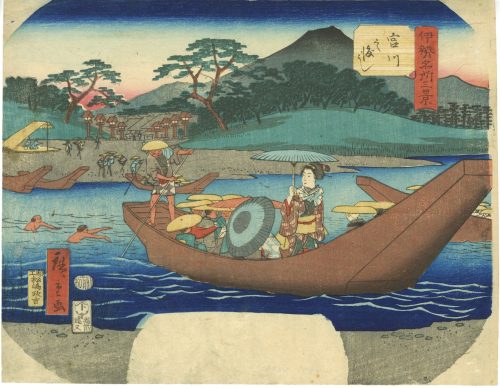 Artist: Utagawa Hiroshige II (二代目 歌川広重] (Japanese, 1826 – 1869). Signed: Hiroshige ga. Publisher: Enshūya Matabei [遠州屋又兵衛] (Japanese, fl. c. 1768 – 1881); (Enmata [遠又]), seal 22-009 (Marks). Block carver: Matsushima Masakichi (Japanese, fl. c. 1847-65); seal: [松嶋彫政] – Hori Masa (Frieze, 2009: 142). Combined date seal and kiwame censor seal: Bunkyū 2 (1862). Media: Fan print (uchiwa-e, 団扇絵), 230 x 298 mm Series: Three Famous Views in Ise [伊勢名所三景] (Ise meisho sankei).
Artist: Utagawa Hiroshige II (二代目 歌川広重] (Japanese, 1826 – 1869). Signed: Hiroshige ga. Publisher: Enshūya Matabei [遠州屋又兵衛] (Japanese, fl. c. 1768 – 1881); (Enmata [遠又]), seal 22-009 (Marks). Block carver: Matsushima Masakichi (Japanese, fl. c. 1847-65); seal: [松嶋彫政] – Hori Masa (Frieze, 2009: 142). Combined date seal and kiwame censor seal: Bunkyū 2 (1862). Media: Fan print (uchiwa-e, 団扇絵), 230 x 298 mm Series: Three Famous Views in Ise [伊勢名所三景] (Ise meisho sankei). -
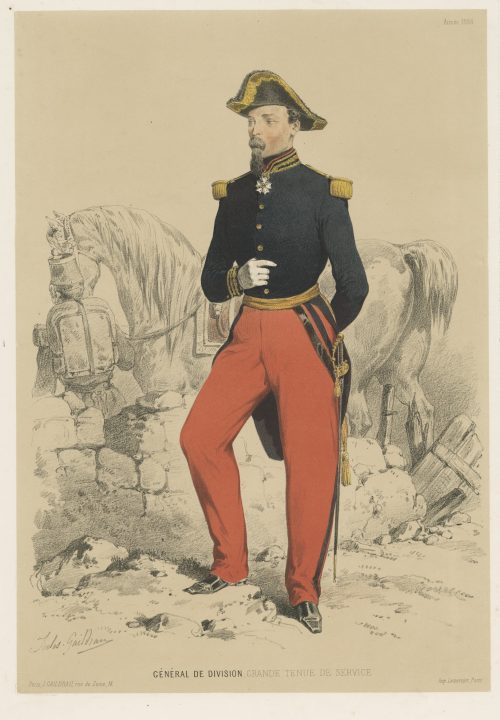 Chromolithography on thick wove paper, 473 x 315 mm sheet, 372 x 260 mm image, black ink stamp “5050” to reverse. Signed on stone "Jules Gaildrau"; below centre: "GÉNERAL DE DIVISION, GRANDE TENUE DE SERVICE"; Bottom left: "Paris, J. Gaildrau, rue de Seine, 16"; right: "Imp. Lemercier, Paris." Joseph Lemercier (French, 1803 – 1887) – printer. Jules Gaildrau (French, 1816 – 1898) – artist.
Chromolithography on thick wove paper, 473 x 315 mm sheet, 372 x 260 mm image, black ink stamp “5050” to reverse. Signed on stone "Jules Gaildrau"; below centre: "GÉNERAL DE DIVISION, GRANDE TENUE DE SERVICE"; Bottom left: "Paris, J. Gaildrau, rue de Seine, 16"; right: "Imp. Lemercier, Paris." Joseph Lemercier (French, 1803 – 1887) – printer. Jules Gaildrau (French, 1816 – 1898) – artist. -
 Artist: Utagawa Toyokuni I [歌川豊国] (1769–1825). Title: 「しなのやおこん 瀬川菊之丞」「帯屋長右衛門 嵐雛助」 Kabuki play: Katsuragawa Renri no Shigarami [桂川連理柵]. According to Waseda University Cultural Resource Database, the play was performed at Ichimura-za (Edo) on the 2nd month of Kansei 12 (year 1800) under the title 楼門五山桐 さんもんごさんのきり. Publisher: Nishimuraya Yohachi [西村屋与八] (Japanese, c. 1751 – 1869)., Play by Suga Sensuke [菅専助] (ca. 1728 – 1791) in two acts. First performed at Kita Horie-za in Osaka in October 1776. Based on a real incident occurring sometime in the Kyōhō era (1716-35), this story was first dramatized in 1761. The first Kabuki drama to stem from this play was in 1777 at Osaka's Araki-za. Obiya Chōemon, a married obi merchant (sitting with abacus) in his forties, meets his neighbour's daughter Ohan (standing behind Obiya), who is young enough to be his daughter, at an inn in Ishibe; the two fall in love and pledged their troth. Ohan becomes pregnant. After a series of misfortunes, the lovers rush to Katsuragawa (Katsura River), where they drown themselves.
Artist: Utagawa Toyokuni I [歌川豊国] (1769–1825). Title: 「しなのやおこん 瀬川菊之丞」「帯屋長右衛門 嵐雛助」 Kabuki play: Katsuragawa Renri no Shigarami [桂川連理柵]. According to Waseda University Cultural Resource Database, the play was performed at Ichimura-za (Edo) on the 2nd month of Kansei 12 (year 1800) under the title 楼門五山桐 さんもんごさんのきり. Publisher: Nishimuraya Yohachi [西村屋与八] (Japanese, c. 1751 – 1869)., Play by Suga Sensuke [菅専助] (ca. 1728 – 1791) in two acts. First performed at Kita Horie-za in Osaka in October 1776. Based on a real incident occurring sometime in the Kyōhō era (1716-35), this story was first dramatized in 1761. The first Kabuki drama to stem from this play was in 1777 at Osaka's Araki-za. Obiya Chōemon, a married obi merchant (sitting with abacus) in his forties, meets his neighbour's daughter Ohan (standing behind Obiya), who is young enough to be his daughter, at an inn in Ishibe; the two fall in love and pledged their troth. Ohan becomes pregnant. After a series of misfortunes, the lovers rush to Katsuragawa (Katsura River), where they drown themselves.Segawa Kikunojō III (Japanese, 1751 – 1810); other names: Segawa Senjo, Segawa Rokō III, Segawa Tomisaburō I, Ichiyama Tomisaburō, Ichiyama Shichinosuke. The actor held the name of Segawa Kikunojō III from the 11th lunar month of 1774 to the 7th lunar month of 1801. He surpassed all the actors of his time in both female and male roles, especially in the former, and achieved tremendous public acclaim.
Arashi Hinasuke II [嵐雛助] (Japanese, c. 1774 – 1801); other names: Nakamura Jūzō III, Kanō Hidenosuke I, Arashi Hidenosuke I. The actor held the name of Arashi Hinasuke II from the 1st lunar month of 1794 to the 2nd lunar month of 1801. Hi died in Edo on the 4th day of the 2nd lunar month of 1801. For the same characters illustrated by Utagawa Kuniyoshi see SVJP-0333.2021. Sources:
Sources:
- Historical Dictionary of Japanese Traditional Theatre By Samuel L. Leiter. Second edition, 2014.
- Kabuki Encyclopedia. An English-Langauge Adaptation of Kabuki Jiten. Samuel L. Leiter. Greenwood Press, 1979.
- http://www.kabuki21.com/
- Waseda University Cultural Resource Database
-
 Ogata Gekkō [尾形月耕] (Japanese, 1859 – 1920). An uchiwa-e (fan-print) of advertisement of tobacco of Kagoshima Prefecture, c. 1890 (Meiji Period). Barefoot Tengu* is sitting on a torii (entrance to a Shinto shrine), smoking a cigarette through a mouthpiece. _______ * Tengu [天狗] (heavenly dog) is a type of legendary creature found in Japanese folk religion and are also considered a type of Shinto god (kami) or yōkai (supernatural beings).
Ogata Gekkō [尾形月耕] (Japanese, 1859 – 1920). An uchiwa-e (fan-print) of advertisement of tobacco of Kagoshima Prefecture, c. 1890 (Meiji Period). Barefoot Tengu* is sitting on a torii (entrance to a Shinto shrine), smoking a cigarette through a mouthpiece. _______ * Tengu [天狗] (heavenly dog) is a type of legendary creature found in Japanese folk religion and are also considered a type of Shinto god (kami) or yōkai (supernatural beings). -
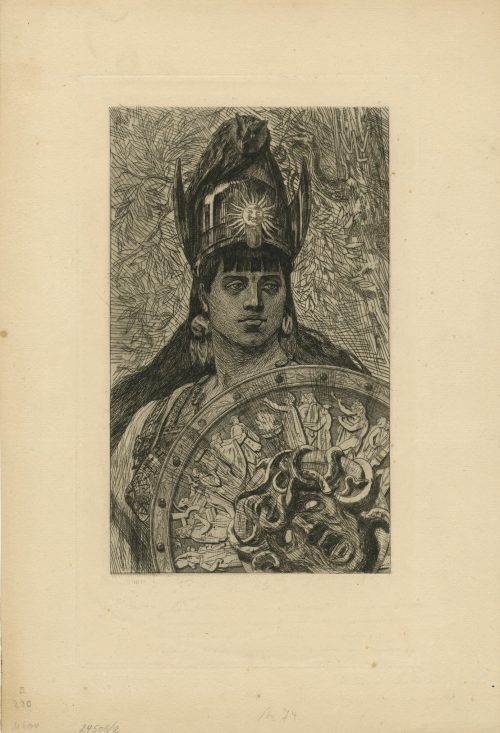
Etching and drypoint on wove paper, depicting Athena with an awl on her helmet and holding a shield with Medusa head. Owner's stamp 'LvM' on verso.
Dimensions: Paper: 38.7 x 26.5 cm; Plate: 31 x 18 cm; Image: 24.5 x 14.5 cm.
Catalogue raisonné: Arthur Hubschmid (1977): 317; Graphics irreverent and erotic (1968): 41.
-
 Artist: Utagawa Kunisada [歌川 国貞] a.k.a. Utagawa Toyokuni III [三代歌川豊国] (Japanese, 1786 – 1865). Artists signature: Kunisada ga [国貞画] in a red double-gourd cartouche. Character: Kabuki actor Ichikawa Danjūrō VII [七代目 市川 團十郎]; other names: Ichikawa Ebizō V, Ichikawa Shinnosuke I (Japanese, 1791 – 1859). Series: Six choice modern flowers [當世六花撰] (Tosei rok’kasen). No publisher's seal, no date or censor's seal is present. Size: Fan print (aiban uchiwa-e); 232 x 289 mm. Provenance: Paul F. Walter. Izzard: "... six prints make up this set of fan prints, which compares contemporary artists with classic poets, in this case, Ichikawa Danjūrō VII with Ōtomo no Kuronushi [大友 黒主] (Japanese, dates unknown)". Rok'kasen [六歌仙] – six poetry immortals. According to Izzard, identification of the portrayed person is made possible by mimasu-mon [三升] on the robe, scrolling peony on the back of the mirror, and cloth decorated with the characters Yauan, one of the actor's poetry names, and other signs and symbols, including the inscription of the acter's guild name Naritaya. The absence of the publisher’s emblem and censorship seals may indicate that this was a privately issued print, not for public use. Ref: (1) [LIB-2967.2022] Utagawa Kunisada (1786 – 1865): His world revisited / Catalogue № 17, Exhibition March 17-21, 2021. — NY: Sebastian Izzard, LLC., 2021; p. 130-1, fig. 42). (2) Lyon Collection. Mimasu-mon, or Mitsumasu, is the Ichikawa Danjūrō family crest – three wooden measures, nested square boxes.
Artist: Utagawa Kunisada [歌川 国貞] a.k.a. Utagawa Toyokuni III [三代歌川豊国] (Japanese, 1786 – 1865). Artists signature: Kunisada ga [国貞画] in a red double-gourd cartouche. Character: Kabuki actor Ichikawa Danjūrō VII [七代目 市川 團十郎]; other names: Ichikawa Ebizō V, Ichikawa Shinnosuke I (Japanese, 1791 – 1859). Series: Six choice modern flowers [當世六花撰] (Tosei rok’kasen). No publisher's seal, no date or censor's seal is present. Size: Fan print (aiban uchiwa-e); 232 x 289 mm. Provenance: Paul F. Walter. Izzard: "... six prints make up this set of fan prints, which compares contemporary artists with classic poets, in this case, Ichikawa Danjūrō VII with Ōtomo no Kuronushi [大友 黒主] (Japanese, dates unknown)". Rok'kasen [六歌仙] – six poetry immortals. According to Izzard, identification of the portrayed person is made possible by mimasu-mon [三升] on the robe, scrolling peony on the back of the mirror, and cloth decorated with the characters Yauan, one of the actor's poetry names, and other signs and symbols, including the inscription of the acter's guild name Naritaya. The absence of the publisher’s emblem and censorship seals may indicate that this was a privately issued print, not for public use. Ref: (1) [LIB-2967.2022] Utagawa Kunisada (1786 – 1865): His world revisited / Catalogue № 17, Exhibition March 17-21, 2021. — NY: Sebastian Izzard, LLC., 2021; p. 130-1, fig. 42). (2) Lyon Collection. Mimasu-mon, or Mitsumasu, is the Ichikawa Danjūrō family crest – three wooden measures, nested square boxes.
-
 Artist: Utagawa Kunisada [歌川 国貞] a.k.a. Utagawa Toyokuni III [三代歌川豊国] (Japanese, 1786 – 1865). Signed: Ichiyōsai Toyokuni hitsu [一陽斎豊国筆]. Inscriptions: [松竹梅] Shochikubai = pine (matsu, 松), bamboo (take, 竹), and plum (ume, 梅) – an auspicious grouping known as "The Three Friends of Winter"; [三福追] (Sanpuku tsui) – the three delights, or pleasures. Date seal and aratame censor seal: Ansei 2, 1st month (1855). Publisher: Ibaya Senzaburō [伊場屋仙三郎] (Japanese, c. 1815 – 1869). Block carver: Yokokawa Takejirō [横川竹二郎] (Japanese, fl. 1845 – 1863); seal: Hori Take [彫竹]. Kabuki actor Nakamura Shikan IV [中村芝翫] (Nakamura Fukusuke I [中村福助], Nakamura Masanosuke I, Nakamura Komasaburō, Nakamura Tamatarō I, Japanese, 1831 – 1899) arranging a branch of blossoming plum to the memorial portrait of his predecessor Nakamura Utaemon IV [中村歌右衛門] (Nakamura Shikan II, Nakamura Tsurusuke I, Nakamura Tōtarō, Japanese, 1796 – 1852); the latter is dressed in a black robe adorned with a mokkō-crest (mon) of white plum blossom, the hanging scroll border decorated with arabesque and plum blossoms. Actors identified by Horst Graebner. Two fan prints from this series in Varshavsky Collection:
Artist: Utagawa Kunisada [歌川 国貞] a.k.a. Utagawa Toyokuni III [三代歌川豊国] (Japanese, 1786 – 1865). Signed: Ichiyōsai Toyokuni hitsu [一陽斎豊国筆]. Inscriptions: [松竹梅] Shochikubai = pine (matsu, 松), bamboo (take, 竹), and plum (ume, 梅) – an auspicious grouping known as "The Three Friends of Winter"; [三福追] (Sanpuku tsui) – the three delights, or pleasures. Date seal and aratame censor seal: Ansei 2, 1st month (1855). Publisher: Ibaya Senzaburō [伊場屋仙三郎] (Japanese, c. 1815 – 1869). Block carver: Yokokawa Takejirō [横川竹二郎] (Japanese, fl. 1845 – 1863); seal: Hori Take [彫竹]. Kabuki actor Nakamura Shikan IV [中村芝翫] (Nakamura Fukusuke I [中村福助], Nakamura Masanosuke I, Nakamura Komasaburō, Nakamura Tamatarō I, Japanese, 1831 – 1899) arranging a branch of blossoming plum to the memorial portrait of his predecessor Nakamura Utaemon IV [中村歌右衛門] (Nakamura Shikan II, Nakamura Tsurusuke I, Nakamura Tōtarō, Japanese, 1796 – 1852); the latter is dressed in a black robe adorned with a mokkō-crest (mon) of white plum blossom, the hanging scroll border decorated with arabesque and plum blossoms. Actors identified by Horst Graebner. Two fan prints from this series in Varshavsky Collection:
SVJP-0336.2021
-
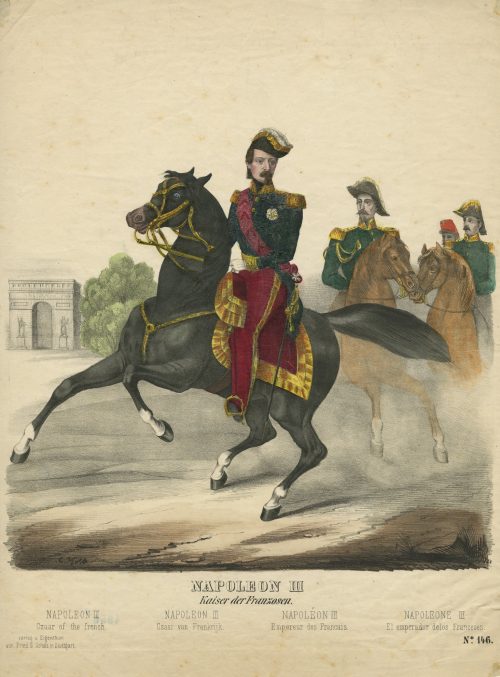 Hand-coloured lithography on wove paper 423 x 332 mm; On reverse: black ink stamp “4956”, ms “A”, ms pencil “428” and “Ernest”. Under the image, centre: "NAPOLEON III | Kaiser der Franzosen." Velow: | NAPOLEON III | Czaar of the French — NAPOLEON III | Czaar van Frankrijk — NAPOLÉON III | Empereur des Francais. — NAPOLEONE III | El emperador delos Franceses; bottom left: "Verlag u. Eigenthum | von. Fried. G. Schulz in Stuttgart.", right: "No 146." The artist's and printer's names in stone are not legible. Published in Stuttgart by Friederich Gustav Schulz (German, 1786 – 1859) during the time of the Second French Empire (1852-1870).
Hand-coloured lithography on wove paper 423 x 332 mm; On reverse: black ink stamp “4956”, ms “A”, ms pencil “428” and “Ernest”. Under the image, centre: "NAPOLEON III | Kaiser der Franzosen." Velow: | NAPOLEON III | Czaar of the French — NAPOLEON III | Czaar van Frankrijk — NAPOLÉON III | Empereur des Francais. — NAPOLEONE III | El emperador delos Franceses; bottom left: "Verlag u. Eigenthum | von. Fried. G. Schulz in Stuttgart.", right: "No 146." The artist's and printer's names in stone are not legible. Published in Stuttgart by Friederich Gustav Schulz (German, 1786 – 1859) during the time of the Second French Empire (1852-1870). -

-
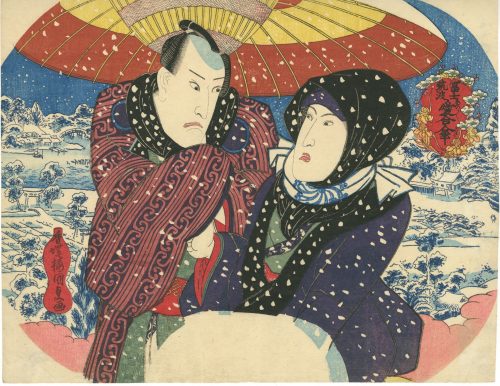 Artist: Utagawa Kunisada [歌川 国貞], a.k.a. Utagawa Toyokuni III [三代 歌川 豊国] (Japanese, 1786 – 1865). An untrimmed fan print titled Fuji Tsukuba aiaigasa, shows the actors Nakamura Shikan II [二代目中村芝翫] and the onnagata actor Iwai Kumesaburō II [岩井粂三郎] sharing an umbrella against the snow. Tsukuba, about 50 kilometres from Edo, was an area where both Fuji and Mount Tsukuba could be viewed together. Mount Fuji being the female and Mount Tsukuba the male. An aizuri-e background (common to all the designs in this set). A play on images and words. Actors: Nakamura Utaemon IV [中村歌右衛門] (Japanese, 1796 – 1852); other names: Nakamura Shikan II [二代目中村芝翫], Nakamura Tsurusuke I, Nakamura Tōtarō. Iwai Hanshirō VI [[岩井半四郎] (Japanese, 1799 – 1836); other names: Iwai Hanshirō VI, Iwai Kumesaburō II [岩井粂三郎], Iwai Hisajirō I, Baiga (poetry name), Shūka (poetry name). Publisher: Ibaya Senzaburo [伊場屋仙三郎] (Japanese, fl. c. 1845 – 1847). Date: circa 1832. Signed: Kōchōrō Kunisada ga in a red double-gourd cartouche. From the series of fan prints:
Artist: Utagawa Kunisada [歌川 国貞], a.k.a. Utagawa Toyokuni III [三代 歌川 豊国] (Japanese, 1786 – 1865). An untrimmed fan print titled Fuji Tsukuba aiaigasa, shows the actors Nakamura Shikan II [二代目中村芝翫] and the onnagata actor Iwai Kumesaburō II [岩井粂三郎] sharing an umbrella against the snow. Tsukuba, about 50 kilometres from Edo, was an area where both Fuji and Mount Tsukuba could be viewed together. Mount Fuji being the female and Mount Tsukuba the male. An aizuri-e background (common to all the designs in this set). A play on images and words. Actors: Nakamura Utaemon IV [中村歌右衛門] (Japanese, 1796 – 1852); other names: Nakamura Shikan II [二代目中村芝翫], Nakamura Tsurusuke I, Nakamura Tōtarō. Iwai Hanshirō VI [[岩井半四郎] (Japanese, 1799 – 1836); other names: Iwai Hanshirō VI, Iwai Kumesaburō II [岩井粂三郎], Iwai Hisajirō I, Baiga (poetry name), Shūka (poetry name). Publisher: Ibaya Senzaburo [伊場屋仙三郎] (Japanese, fl. c. 1845 – 1847). Date: circa 1832. Signed: Kōchōrō Kunisada ga in a red double-gourd cartouche. From the series of fan prints:
Two more prints from the series 'Fuji and Tsukuba sharing an umbrella' (Fuji Tsukuba aiaigasa), not in this Collection:
SVJP-0342.2021

Kabuki actors Onoe Kikugorō III and Iwai Kumesaburo II. Year: c. 1832; Publisher: No seal; Signed: Kōchōrō Kunisada ga From Kunisada Project. 
Kabuki actors Bandō Minosuke II and Iwai Shijaku I. Year: c. 1832; Publisher: No seal; Signed: Kōchōrō Kunisada ga From Kunisada Project. -
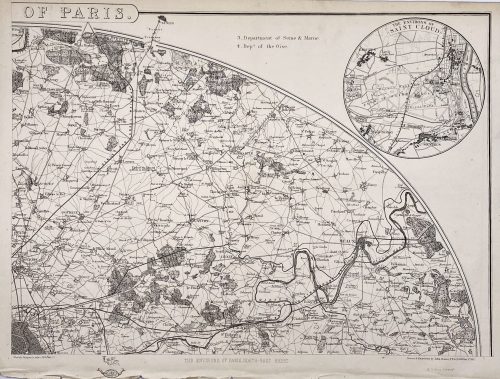 Four maps 34 x 47.5 cm each. Include insets of Versailles, Fontainebleau, Saint Cloud and St. Germain en Laye. Lithograph by Edward Weller after a map drawn and engraved by John Dower. "These maps originally appeared in the Weekly Dispatch newspaper from 1856 to 1862. They were reissued between 1863 and 1867 by Cassell, Petter and Galpin and then published collectively as Cassell's Atlas. The plates were acquired by G.W. Bacon & Co., and reissued in 1876 under the title Bacon's New Quarto Atlas ... of the Counties of England, and many times since under various titles." [WorldCat]
Four maps 34 x 47.5 cm each. Include insets of Versailles, Fontainebleau, Saint Cloud and St. Germain en Laye. Lithograph by Edward Weller after a map drawn and engraved by John Dower. "These maps originally appeared in the Weekly Dispatch newspaper from 1856 to 1862. They were reissued between 1863 and 1867 by Cassell, Petter and Galpin and then published collectively as Cassell's Atlas. The plates were acquired by G.W. Bacon & Co., and reissued in 1876 under the title Bacon's New Quarto Atlas ... of the Counties of England, and many times since under various titles." [WorldCat]Dimensions: 34 x 47.5 cm each.
Contributors: Weller, Edward (British, 1819 – 1884) – lithographer. Dower, John Crane (British, 1791 – 1847) – artist, engraver. Dower, John James (British, 1825 – 1901) – artist, engraver (son of John Crane Dower). -
 Poem by Ariwara no Narihira Ason: (Actor Ichikawa Danjûrô VIII as) Seigen, from the series Comparisons for Thirty-six Selected Poems (Mitate sanjûrokkasen no uchi)「見立三十六歌撰之内 有原業平朝臣 清玄」 八代目市川団十郎. Poem: Yo no naka ni/ taete sakura no/ nakariseba/ haru no kokoro wa/ nodokekaramashi. Kabuki actor: Ichikawa Danjūrō VIII [八代目 市川 團十郎] (Japanese, 1823 – 1854); other names: Ichikawa Ebizô VI, Ichikawa Shinnosuke II. Artist: Utagawa Kunisada [歌川 国貞] a.k.a. Utagawa Toyokuni III [三代歌川豊国] (Japanese, 1786 – 1865). Block cutter: Yokokawa Horitake [横川彫武] a.k.a. Yokokawa Takejiro [横川竹二郎] (Japanese, fl. 1860s). Publisher: Iseya Kanekichi [伊勢屋兼吉] (Japanese, fl. 1840s – c. 1875) Year: 1852 (Kaei 5), 10th month. Size: Vertical ōban; 36.5 × 25.4 cm. Signed: Toyokuni ga, in toshidama cartouche [豊国画(年玉枠] Censors' seals: Fuku, (Muramatsu), Rat 10. Ref: MFA Accession № 11.36779.43.
Poem by Ariwara no Narihira Ason: (Actor Ichikawa Danjûrô VIII as) Seigen, from the series Comparisons for Thirty-six Selected Poems (Mitate sanjûrokkasen no uchi)「見立三十六歌撰之内 有原業平朝臣 清玄」 八代目市川団十郎. Poem: Yo no naka ni/ taete sakura no/ nakariseba/ haru no kokoro wa/ nodokekaramashi. Kabuki actor: Ichikawa Danjūrō VIII [八代目 市川 團十郎] (Japanese, 1823 – 1854); other names: Ichikawa Ebizô VI, Ichikawa Shinnosuke II. Artist: Utagawa Kunisada [歌川 国貞] a.k.a. Utagawa Toyokuni III [三代歌川豊国] (Japanese, 1786 – 1865). Block cutter: Yokokawa Horitake [横川彫武] a.k.a. Yokokawa Takejiro [横川竹二郎] (Japanese, fl. 1860s). Publisher: Iseya Kanekichi [伊勢屋兼吉] (Japanese, fl. 1840s – c. 1875) Year: 1852 (Kaei 5), 10th month. Size: Vertical ōban; 36.5 × 25.4 cm. Signed: Toyokuni ga, in toshidama cartouche [豊国画(年玉枠] Censors' seals: Fuku, (Muramatsu), Rat 10. Ref: MFA Accession № 11.36779.43. -
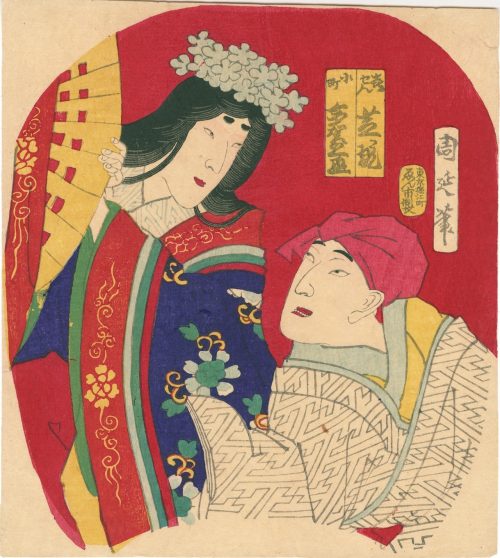 Artist: Toyohara Chikanobu [豊原周延] (Japanese, 1838 – 1912) Signed: Chikanobu hitsu [周延筆] Publisher: [ 東京掘江町] Tokyo Horiemachi | [えん市製] Enshi-sei. Media: Fan print (uchiwa-e, 団扇絵), 192 x 172 mm. Possibly Iwai Kumesaburō IV [岩井粂三郎] (1856 – 1886) a.k.a. Iwai Hisajirō III [岩井久次郎] in the role of Ono no Komachi [小野乃小町] and Nakamura Shikan IV [中村芝翫] in the role of Kisen Hōshi [喜せん法師]. Play: The Six Immortal Poets in Colorful Guises [六歌仙体綵] (Rokkasen Sugata no irodori). Inscription: Left: Kisen [喜せん] | Shikan [芝翫] Right: Komachi [小町] | Kumesaburō [粂三郎]. Actors: Iwai Kumesaburō IV [岩井粂三郎] (1856 – 1886) a.k.a. Iwai Hisajirō III [岩井久次郎]. Nakamura Shikan IV [中村芝翫] (Japanese, 1831 – 1899); other names: Nakamura Fukusuke I [中村福助], Nakamura Masanosuke I, Nakamura Komasaburō, Nakamura Tamatarō I.
Artist: Toyohara Chikanobu [豊原周延] (Japanese, 1838 – 1912) Signed: Chikanobu hitsu [周延筆] Publisher: [ 東京掘江町] Tokyo Horiemachi | [えん市製] Enshi-sei. Media: Fan print (uchiwa-e, 団扇絵), 192 x 172 mm. Possibly Iwai Kumesaburō IV [岩井粂三郎] (1856 – 1886) a.k.a. Iwai Hisajirō III [岩井久次郎] in the role of Ono no Komachi [小野乃小町] and Nakamura Shikan IV [中村芝翫] in the role of Kisen Hōshi [喜せん法師]. Play: The Six Immortal Poets in Colorful Guises [六歌仙体綵] (Rokkasen Sugata no irodori). Inscription: Left: Kisen [喜せん] | Shikan [芝翫] Right: Komachi [小町] | Kumesaburō [粂三郎]. Actors: Iwai Kumesaburō IV [岩井粂三郎] (1856 – 1886) a.k.a. Iwai Hisajirō III [岩井久次郎]. Nakamura Shikan IV [中村芝翫] (Japanese, 1831 – 1899); other names: Nakamura Fukusuke I [中村福助], Nakamura Masanosuke I, Nakamura Komasaburō, Nakamura Tamatarō I. -
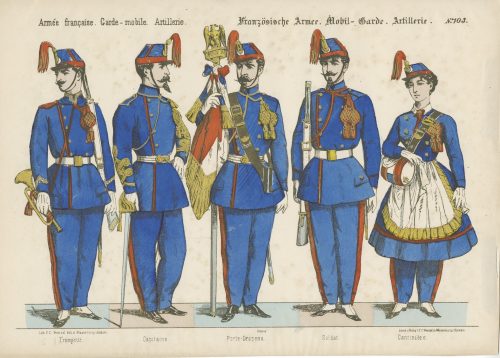 Hand-coloured woodcut on wove paper, 282 x 392 mm; black ink stamp “5051 2” to reverse. Top: "Armée française. Garde–mobile. Artillerie." — (gothic font) "Französische Armee. Mobil–Garde. Artillerie." — "№103". Below left: "Lith F. C. Wentzel édit. à Wissembourg. (Alsacé); center: Déposé; right: Druck u. Verlag v. F. C. Wentzel in Weissemburg. (Elsass)."; Bottom: "Trompette" — "Capitaine" — "Porte-Drapeau". — "Soldat" — "Cantinière." Jean Frédéric Wentzel (French, 1807 – 1869) – publisher/printer.
Hand-coloured woodcut on wove paper, 282 x 392 mm; black ink stamp “5051 2” to reverse. Top: "Armée française. Garde–mobile. Artillerie." — (gothic font) "Französische Armee. Mobil–Garde. Artillerie." — "№103". Below left: "Lith F. C. Wentzel édit. à Wissembourg. (Alsacé); center: Déposé; right: Druck u. Verlag v. F. C. Wentzel in Weissemburg. (Elsass)."; Bottom: "Trompette" — "Capitaine" — "Porte-Drapeau". — "Soldat" — "Cantinière." Jean Frédéric Wentzel (French, 1807 – 1869) – publisher/printer.




